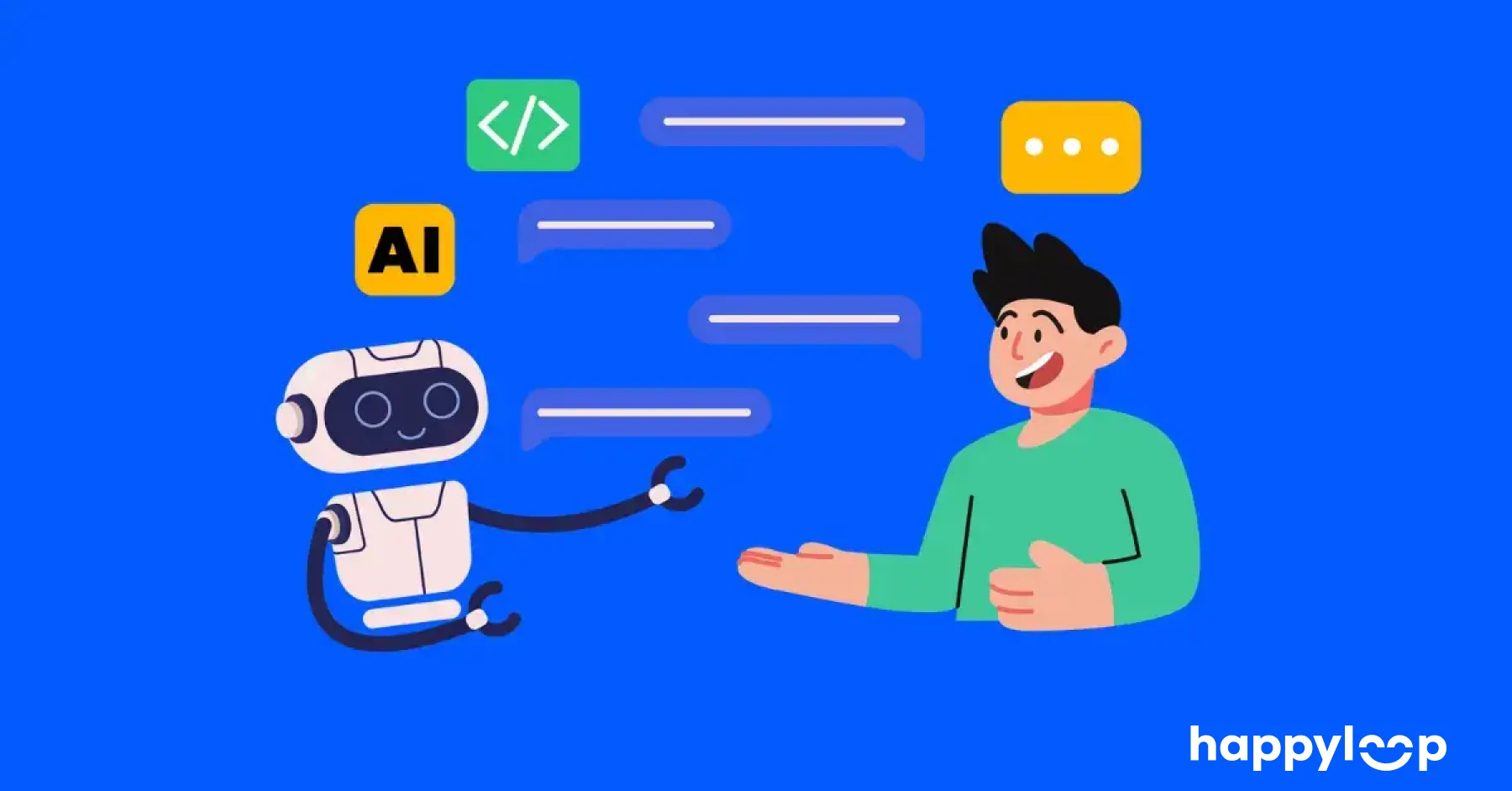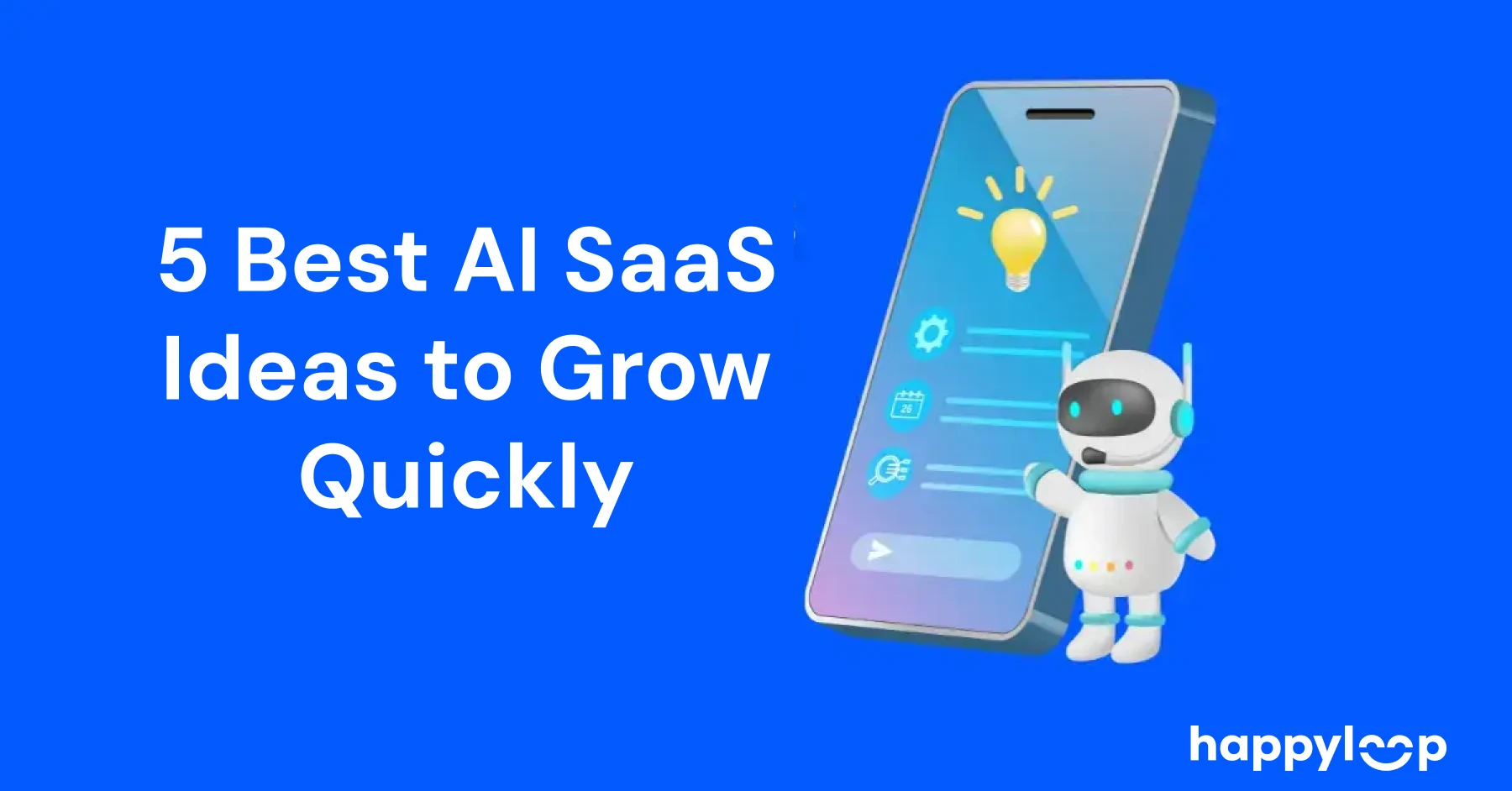AI SaaS has moved from buzzword to business backbone. With cloud-native infrastructure, mature APIs, and enterprise-grade models, founders can now build revenue-generating products faster than ever. This guide goes deep into six high‑potential AI SaaS ideas for 2025 - complete with who they serve, why now, monetization, go‑to‑market, and a 30‑day MVP plan.
TL;DR: AI in SaaS creates leverage: automate workflows, personalize at scale, and turn raw data into real‑time decisions. The global SaaS market is projected to exceed $200 billion in 2024 (Statista Market Insights), while studies estimate AI could add up to $13 trillion in additional economic output by 2030 (McKinsey) and could contribute up to $15.7 trillion to global GDP by 2030 (PwC). If you’re building in 2025, you’re right on time.
Table of Contents
What Is AI SaaS?
AI SaaS (Artificial Intelligence Software‑as‑a‑Service) delivers AI‑powered capabilities as cloud‑based software - such as prediction, generation, classification, and personalization - through subscription pricing. These SaaS platforms act as continuously improving Software‑as‑a‑Service products, so customers access new features without installing or maintaining infrastructure.
- Common AI modalities: Natural Language Processing (NLP), Natural Language Understanding (NLU), computer vision, speech, Recurrent Neural Networks (RNNs) for sequences, recommendation engines, forecasting, and generative AI (text, image, audio, video) powered by modern machine learning algorithms.
- Benefits: faster time‑to‑value, lower total cost of ownership, automatic updates, built‑in scalability, and integrations with the tools teams already use.
- Ecosystem: Built on cloud infrastructure, delivered as SaaS platforms/cloud‑based software with automated updates, and extended via low‑code platforms, CMS integrations, CRM systems, and data connectors.
AI SaaS vs. Traditional Software (Key Differences)
Here’s how AI SaaS differs from one‑time‑license software:
| Dimension |
AI SaaS |
Traditional Software |
| Delivery |
Cloud; browser/API access |
On‑prem install, device‑bound |
| Pricing |
Subscription, usage‑based add‑ons |
Perpetual/annual license + maintenance |
| Updates |
Continuous, automatic |
Periodic manual updates/patches |
| AI capabilities |
Managed models, prompt tooling, evaluators |
Manual model integration, slower iteration |
| Scalability |
Elastic, multi‑tenant |
Capacity‑constrained per install |
| Security & Compliance |
Centralized controls (SOC 2/ISO27001 options) |
Customer‑managed; varied posture |
| Integrations |
Native connectors (Slack, Google, CRM, ERP) |
Often custom/professional services |
| Data Network Effects |
Aggregate usage improves models |
Limited to local datasets |
How We Chose These 6 Ideas
- Big pain, measurable ROI: time saved, revenue increased, churn reduced.
- High‑quality data access and strong integration surface (APIs, file formats, workflows).
- Clear wedge: a niche where AI outperforms manual or rules‑based tools.
- Monetization clarity: seat‑based + usage‑based add‑ons or value‑based plans.
- Low 30‑day MVP risk: can ship a narrow, delightful version fast.
- No‑Code MVP friendly: initial validation possible with low‑code platforms before full build - ideal for micro‑SaaS experiments.
1. Remote Team Culture Builder
![Team Builder AI - virtual team activities, sentiment, engagement]()
Elevator pitch: An AI copilot for distributed culture - plan rituals, suggest activities, measure sentiment, and predict burnout risk directly in Slack/Teams.
- Who it’s for: remote‑first companies, fast‑growing startups, HR/People Ops leaders, engineering managers.
- Why now: hybrid/remote is sticky; engagement, customer experience, and retention are board‑level metrics. Personalized experiences can lift conversion/engagement dramatically.
- Core features: weekly pulse checks; topic and sentiment analysis; auto‑generated team‑building activities agendas; virtual events calendar; employee engagement tools (recognition, kudos); Interview board kits for hiring events; manager coaching nudges; optional Audience Monitoring for all‑hands sentiment.
- AI: sentiment/NLU for messages, time‑series risk scoring, generative content for rituals, policy‑compliant privacy filters.
- Tech stack: Slack/Teams apps, vector search, LLM for generation, analytics store (Postgres/BigQuery), auth (SAML/OIDC).
- Monetization: $4–$9 per user/month; usage add‑ons for advanced analytics; annual plans with SLAs.
- Go‑to‑market: partner with remote‑work communities; PLG with Slack app store; content on burnout prevention and manager enablement.
- Risks: privacy perception - mitigate with anonymization, opt‑ins, clear data policies, SOC 2.
- MVP in 30 days: Slack bot + weekly pulse → dashboard → 3 ready‑made ritual templates → sentiment chart → manager nudges.
2. Microlearning Platform for Professionals
![AI Microlearning Platform - SOPs, playbooks, spaced repetition]()
Elevator pitch: Turn elite company SOPs and playbooks into 7‑minute micro‑lessons with quizzes, flashcards, and on‑the‑job reminders.
- Who it’s for: sales, support, ops, and onboarding teams; agencies; SMBs scaling processes; content creators building repeatable systems.
- Why now: attention budgets are shrinking; managers need measurable upskilling that fits work.
- Core features: SOP → lesson converter; spaced‑repetition quizzes; skill pathing; AI coach for practice scenarios; mock interview practice to improve public speaking skills; LMS integrations; lightweight content creation workflows (scripts/outlines) via a Content Generation Tool; content clustering and library management.
- AI: document parsing, knowledge distillation, question generation, adaptive difficulty.
- Monetization: $8–$15 per seat; course marketplace revenue share; enterprise SSO.
- GTM: niche vertical playbooks (e.g., CX, RevOps); creators/experts as partners; YouTube/LinkedIn tutorials; certification badges; launch a focused Landing Page to validate demand early.
- MVP in 30 days: upload SOP → generate lessons + 10 questions → completion tracking → Slack nudges; Stripe checkout.
3. Virtual Interior Design Assistant
![AI Interior Design - style detection, AR visualization, shopping]()
Elevator pitch: Upload a room photo and get shoppable, to‑scale design mockups in your preferred style. Visualize with AR before you buy.
- Who it’s for: homeowners, short‑term rental hosts, interior designers, furniture retailers.
- Core features: style detection; layout suggestions; mood boards; AR visualization; one‑click carts; budget optimization; recommendation engine for products; optional AI Photo Editor enhancements.
- AI: computer vision (room segmentation); generative image inpainting; constraint solver for dimensions/budget; Image & Video Analysis SaaS integrations.
- Monetization: subscription for unlimited renders; affiliate commissions with retailers; pro tier for designers.
- GTM: partner with furniture brands; UGC on TikTok/YouTube; before/after galleries; marketplace listings for hosts.
- MVP in 30 days: 1 room type (living room) → 3 styles → 3D overlay → affiliate links; capture testimonials.
4. AI Spreadsheet Assistant
![AI Spreadsheet Assistant - natural language to formulas/workflows]()
Elevator pitch: Describe what you want in plain English - get formulas, transformations, dedupes, API pulls, and dashboards instantly in Sheets/Excel.
- Who it’s for: growth marketers, ops, finance analysts, real estate, lead gen teams.
- Core features: NL → formula; data cleaning; enrichment via APIs; web scraping where permitted; dedupe and merge; chart auto‑build; reusable recipes; templates for inventory management and marketing efforts. Advanced spreadsheet analysis (pivot tables)
- AI: program synthesis for formulas; semantic column mapping; data validator; pattern learning from usage; powered by modern LLMs (e.g., GPT‑4 API) for complex transformations.
- Monetization: freemium (X requests/month), pro seats, marketplace for premium recipes.
- GTM: template SEO; YouTube micro‑tutorials; integrations with Airtable/Notion; communities (r/excel, Reddit, Discord); fast test with a conversion‑optimized Landing Page; partnerships with accounting platforms and ops tools.
- MVP in 30 days: Chrome add‑on / Sheets add‑on → NL prompt → formula + preview → undo history; 10 best‑selling recipes.
5. AI‑Powered Personal Finance Assistant
![AI Personal Finance - budgeting, goals, optimization, coaching]()
Elevator pitch: A personal finance tracker and copilot that categorizes spend, forecasts cash flow, and gives plain‑language recommendations aligned to your goals or preferred money philosophy - bringing smarter financial planning to everyone.
- Who it’s for: Gen Z/Millennials, freelancers, families optimizing budgets and debt payoff.
- Core features: auto‑budgeting; goal tracking; debt prioritization; bill negotiation prompts; investment nudges; tax reminders; long‑term financial planning scenarios; cash flow forecasting; detection of potential tax deductions.
- AI: transaction classification; anomaly detection; what‑if simulations; personalized nudges; explainable recommendations.
- Monetization: freemium + premium coaching; affiliate revenue (switching accounts/insurers - handled transparently); family plan.
- Compliance: read‑only bank connections; encryption; clear disclaimers “not investment advice”; optional accounting platforms integrations.
- MVP in 30 days: Plaid integration → spend categories → monthly plan → 5 actionable suggestions/week → PDF summary.
6. Humanize Ai
Humanize AI
helps teams make CX feel truly personal - across email, chat, customer service, and onboarding. It blends personalization, tone adaptation, and behavior‑based sequencing so interactions feel helpful, not robotic; includes guardrails for AI Content Moderator use cases and brand‑safe messaging.
- Core features: tone/style mirroring; persona‑aware responses; next‑best‑action suggestions; empathy checks; guardrails.
- AI: sentiment + intent classification; response generation with brand/style constraints; reinforcement from human feedback; proactive AI automation suggestions for digital handoffs to digital workers.
- Monetization: seat‑based pricing + usage; enterprise tier for QA, analytics, redaction.
- MVP in 30 days: Gmail/Helpdesk plugin → brand voice profile → reply suggestions → 1‑click insert → analytics on CSAT/time saved.
Why AI Matters
AI and machine learning improve productivity, enable personalization at scale, and unlock new product experiences. In manufacturing, software, and services, automation raises output and quality. AI‑powered financial tools analyze large datasets to anticipate trends; in retail, recommendations and chat improve CX. Studies estimate AI could add $13T (McKinsey) to $15.7T (PwC) by 2030.
Key AI Trends Shaping SaaS in 2025
- Domain‑specific copilots: embedded in CRM, ERP, spreadsheets, and design tools.
- Multimodal AI: text+image+voice+video unlock richer workflows.
- Autonomous agents (with guardrails): hands‑off task completion in bounded systems.
- Retrieval‑augmented generation (RAG): grounded answers on private data; evaluators as a first‑class feature. See our post on predictive analytics for how grounding and forecasting improve decisions.
- Privacy‑preserving ML: redaction, on‑device inference, differential privacy.
- Vertical AI: best‑in‑class solutions beat horizontal “does‑everything” tools.
- Usage‑based pricing: aligns cost with model/API consumption.
- Content optimization for growth: AI SEO Tool and Content Generation Tool categories (including niche generators like an AI Logo Maker) help content creators scale output and improve rankings - directly supporting marketing teams’ data analytics and marketing efforts.
- Platform acceleration: ubiquity of GPT‑4 API, low‑code platforms, and managed cloud infrastructure speeds delivery of AI automation features.
More AI SaaS Use Cases and Niches
- Marketing & Growth: SEO‑optimized posts, AI SEO Tool, Audience Monitoring, content clustering, recommendation engine powered promotions.
- Media & Creation: Podcast Generator, podcast creation tool, audio visualiser, video information converter, Speech specialist, AI Logo Maker.
- Data & Ops: Web Scraper/Web Scraping, spreadsheet assistant, predictive dashboards, Business Analytics Platform, contract analysis.
- Commerce & Inventory: inventory management, tracking inventory levels, asset lifecycle management, automated updates.
- Finance: AI‑powered personal Finance Assistant, AI Personal Finance Tracker, cash flow forecasting, predictive risk scoring, tax deductions.
- Health: electronic health records workflows, intelligent triage, secure summarization.
- People & HR: HR Management Tool, employee engagement tools, Interview board automation.
- Trust & Safety: AI Content Moderator, cybersecurity solutions, Fake news detection.
- CX & Service: customer service copilots, recommendation engines, omnichannel routing.
- Integrations: connectors for CRM systems, accounting suites, and CMS integrations.
Pricing Models and the 3‑3‑2‑2‑2 (T2D3) Rule
- Common pricing: seat‑based (predictable), usage‑based (model/API calls), hybrid tiers, outcome‑based for enterprise. Pricing and usage tiers
- Packaging: 3 plans (Good/Better/Best), annual discounts, add‑ons (advanced analytics, SSO, premium support).
- T2D3 growth (aka “3‑3‑2‑2‑2”): a classic SaaS benchmark to scale ARR - triple twice, then double three times, on the path from initial PMF to $100M ARR. Use as a directional north star, not a rigid rule.
Security, Compliance, and Risk
- Security: encryption in transit/at rest; key management; audit logs; RBAC. Security and compliance at HappyLoop
- Compliance: SOC 2 Type II, ISO 27001; GDPR/CCPA; data processing addendum (DPA).
- AI governance: content filters, toxicity checks, human‑in‑the‑loop for sensitive workflows, deterministic fallbacks; solutions for Fake news detection and AI Content Moderator pipelines.
- Data: explicit permissions; data retention windows; opt‑out of training where required; sector‑specific controls for sensitive records (for example, electronic health records). Privacy Policy
How Can HappyLoop Help You? (One of the Best AI SaaS Products)
HappyLoop integrates as a data analysis and insights layer that you can embed in your SaaS - accelerating automation, personalization, and decision‑making across Business Analytics Platform use cases.
1. Automation of Repetitive Tasks
- HappyLoop automates data prep, analysis, and report generation across large datasets, freeing teams to focus on strategy—ideal for AI automation and predictive dashboards. Workflow automation
2. Personalization for Users
- Behavior‑based segmentation, dynamic recommendation engines, and tailored in‑app experiences to lift engagement and conversions.
3. Actionable Insights
- Real‑time dashboards for performance, cohort retention, and funnel analysis with proactive alerts and suggested actions; native connectors to CRM systems and CMS integrations. Real‑time data insights
4. Improving Customer Retention
5. Enhanced Product Value
Frequently Asked Questions
What is AI SaaS?
Cloud‑delivered software that uses AI to automate tasks, make predictions, or generate content, typically via subscription.
How is AI used in SaaS?
Common uses include personalization, forecasting, anomaly detection, classification, summarization, and domain‑specific copilots.
What’s the difference between SaaS and AI SaaS?
AI SaaS includes managed AI capabilities (models, prompts, evaluators) and improves via data network effects; traditional SaaS may be rules‑based without ML.
What is the 3‑3‑2‑2‑2 (T2D3) rule of SaaS?
A growth heuristic: triple revenue twice, then double three times, as a benchmark path to scale ARR toward $100M. Useful as a compass, not a contract.
Why start an AI SaaS in 2025?
Customer demand, mature APIs, accessible models, and a large and growing SaaS market create a founder‑friendly window with clear value props.
What are the most profitable AI SaaS ideas right now?
Vertical, workflow‑critical products with clear ROI tend to monetize best - examples include AI spreadsheet copilots (ops/finance), AI CX assistants (support/revenue), and AI analytics/recommendation layers embedded in existing SaaS.
How much does it cost to build an AI SaaS MVP?
Typical MVPs can be built for $5k–$40k in engineering time and API spend within 30–60 days, depending on data complexity, integrations, and security requirements. Usage‑based model costs should be offset with pricing tiers and quotas.
Can I build an AI SaaS without code?
Yes - no‑code/low‑code tools plus AI APIs can deliver a working MVP (auth, forms, workflows, database, and payments). Engineering becomes essential as you scale security, performance, and custom logic.
Sources
Conclusion
Each of these six AI SaaS ideas targets a meaningful, monetizable problem - where artificial intelligence is not a gimmick but the engine of value. Start narrow, integrate where users live, and prove ROI with one key metric. With the right wedge and an MVP in 30 days, you can be shipping - and learning - this quarter. Further reading: Why you shouldn’t build AI data features in‑house






